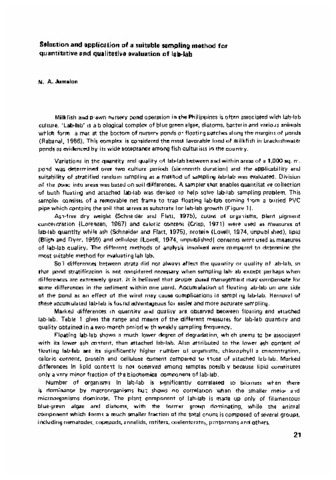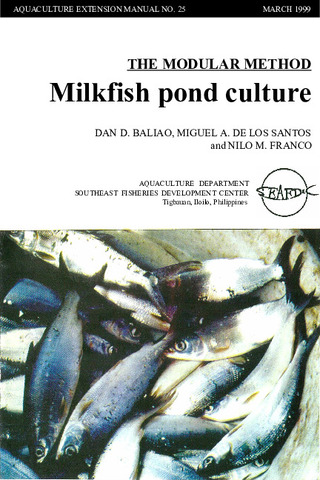Perlihatkan publikasi sederhana
Selection and application of a suitable sampling method for quantitative and qualitative evaluation of lab-lab
| dc.contributor.author | Jumalon, N. A. | |
| dc.date.accessioned | 2015-09-22T05:57:44Z | |
| dc.date.available | 2015-09-22T05:57:44Z | |
| dc.date.issued | 1978 | |
| dc.identifier.citation | Jumalon, N. A. (1978). Selection and application of a suitable sampling method for quantitative and qualitative evaluation of lab-lab. SEAFDEC Aquaculture Department Quarterly Research Report, 2(4), 21–24. | en |
| dc.identifier.uri | http://hdl.handle.net/10862/2337 | |
| dc.description.abstract | Milkfish and prawn pond operation in the Philippines is often associated with lab-lab culture. Lab-lab is a biological complex of blue-green algae, diatoms, bacteria and various animals which form a mat at the bottom of nursery ponds or floating patches along the margins of ponds. This complex is considered the most favorable food of milkfish in brackishwater ponds. Variations in the quantity and quality of lab-lab between and within areas of a 1,000 sq. m. pond was determined over 2 culture periods (6 month duration) and the applicability and suitability of stratified random sampling as a method of sampling lab-lab was evaluated. | |
| dc.language.iso | en | en |
| dc.publisher | Aquaculture Department, Southeast Asian Fisheries Development Center | en |
| dc.subject | Chanos chanos | en |
| dc.subject | Chanidae | en |
| dc.subject | Philippines | en |
| dc.title | Selection and application of a suitable sampling method for quantitative and qualitative evaluation of lab-lab | en |
| dc.type | Article | en |
| dc.citation.volume | 2 | |
| dc.citation.issue | 4 | |
| dc.citation.spage | 21 | |
| dc.citation.epage | 24 | |
| dc.citation.journalTitle | SEAFDEC Aquaculture Department Quarterly Research Report | en |
| dc.subject.asfa | cultured organisms | en |
| dc.subject.asfa | aquaculture techniques | en |
| dc.subject.asfa | brackishwater aquaculture | en |
| dc.subject.asfa | fish culture | en |
| dc.subject.scientificName | Chanos chanos |





